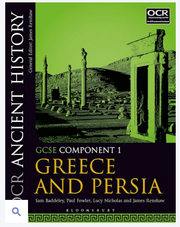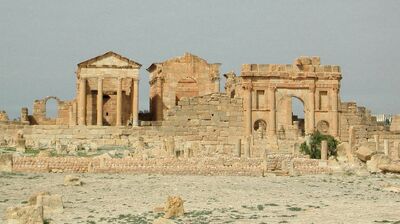No edit summary Tag: Visual edit |
Tag: Visual edit |
||
| (11 intermediate revisions by the same user not shown) | |||
| Line 4: | Line 4: | ||
[[Classical Civilization|Classical Civilisation]] could be a complementary or alternative qualification. |
[[Classical Civilization|Classical Civilisation]] could be a complementary or alternative qualification. |
||
| − | Ancient History covers Roman, Greek and Persian History. |
+ | Ancient History covers Roman, Greek and Persian History.<br /> |
| − | |||
| − | ''*For assessments in 2021 content was reduced, a similar proposal has been made for 2022 but not yet confirmed. Check the specification page for updates.*'' <br /> |
||
== OCR Ancient History GCSE == |
== OCR Ancient History GCSE == |
||
| Line 41: | Line 39: | ||
=== Assessment === |
=== Assessment === |
||
| − | 100% exam based. |
+ | 100% exam based. |
| + | '''Timings have changed for exams in 2024 onwards. Increasing from 1hr 45 to 2hrs.''' |
||
| ⚫ | |||
| + | |||
| ⚫ | |||
** The examination comprises a mixture of short and long-answer questions, and is presented in four sections. |
** The examination comprises a mixture of short and long-answer questions, and is presented in four sections. |
||
| − | ** Section A consists of 60 marks. Section A will assess learners’ knowledge and understanding of the Persian period study. 5 marks are available for SPaG in Section A. |
+ | ** Section A consists of 60 marks. Section A will assess learners’ knowledge and understanding of the Persian period study. 5 marks are available for SPaG in Section A. |
** Students will need to answer '''one''' of Section B, Section C or Section D depending on which Greek depth study they have studied. Sections B, C and D all consist of 45 marks. |
** Students will need to answer '''one''' of Section B, Section C or Section D depending on which Greek depth study they have studied. Sections B, C and D all consist of 45 marks. |
||
| − | * Paper 2 - Rome and its neighbours - |
+ | * Paper 2 - Rome and its neighbours - 2hrs - 100 marks + 5 SPaG marks - 50% |
** The examination comprises a mixture of short and long-answer questions, and is presented in four sections. |
** The examination comprises a mixture of short and long-answer questions, and is presented in four sections. |
||
| − | ** Section A consists of 60 marks. Section A will assess learners’ knowledge and understanding of the Roman longer period study. 5 marks are available for SPaG in Section A. |
+ | ** Section A consists of 60 marks. Section A will assess learners’ knowledge and understanding of the Roman longer period study. 5 marks are available for SPaG in Section A. |
** Students will need to answer '''one''' of Section B, Section C or Section D depending on which Roman depth study they have studied. Sections B, C and D all consist of 45 marks.<br /> |
** Students will need to answer '''one''' of Section B, Section C or Section D depending on which Roman depth study they have studied. Sections B, C and D all consist of 45 marks.<br /> |
||
| + | <br /> |
||
=== Resources === |
=== Resources === |
||
| Line 60: | Line 61: | ||
[https://www.bloomsbury.com/uk/ocr-ancient-history-gcse-component-2-9781350015203/ OCR Ancient History GCSE Component 2 - Rome; By Paul Fowler, Christopher Grocock and James Melville. Published by Bloomsbury] |
[https://www.bloomsbury.com/uk/ocr-ancient-history-gcse-component-2-9781350015203/ OCR Ancient History GCSE Component 2 - Rome; By Paul Fowler, Christopher Grocock and James Melville. Published by Bloomsbury] |
||
| + | |||
| + | ==== Past papers ==== |
||
| + | Past papers can be accessed through the [https://www.ocr.org.uk/qualifications/gcse/ancient-history-j198-from-2017/assessment/ specification page] or [https://www.ocr.org.uk/qualifications/past-paper-finder/ here] |
||
==== Facebook group ==== |
==== Facebook group ==== |
||
| Line 65: | Line 69: | ||
==== Websites ==== |
==== Websites ==== |
||
| + | [https://www.ocr.org.uk/qualifications/gcse/ancient-history-j198-from-2017/planning-and-teaching/ OCR Resources] - topic booklets |
||
| ⚫ | |||
| + | |||
| + | [https://www.bloomsburyonlineresources.com/ocr-gcse-ancient-history/ Bloomsbury Publishing] - Resources linked from the textbook |
||
| + | |||
| ⚫ | |||
| + | |||
| + | [https://www.worldhistory.org/edu/teaching-resources/ World History Encyclopaedia] |
||
| + | |||
| + | [https://classicalassociation.org/for-teachers/resources/ The Classical Association] |
||
| + | ====Distance Learning==== |
||
| + | Many home-educated students study Ancient History GCSE successfully using just the textbook and free online resources, but some find a distance learning course suits their family better, or want to use a tutor occasionally for marking essays or past papers. Course providers can be found on the [[Distance Learning Providers|Distance Learning Providers page]]. |
||
| + | [[Category:Subjects]] |
||
| + | [[Category:Classics]] |
||
Latest revision as of 19:17, 19 September 2023
Ancient History is only available as OCR GCSE. It is 100% exam based assessment so is accessible to home educators.
Classical Civilisation could be a complementary or alternative qualification.
Ancient History covers Roman, Greek and Persian History.
OCR Ancient History GCSE
OCR GCSE Ancient History page and specification
- Exams from: June 2019
- Available in June
- Specification code: J198
Subject Content
Content is broken in to 2 components. The topic areas selected for this specification range from the 8th century BC to the 1st century AD.
Component 1: Greece and Persia
Compulsory period study: The Persian Empire, 559–465 BC
Choice of one Depth Study from:
- From Tyranny to Democracy, 546—483 BC
- Athens in the Age of Pericles, 462—429 BC
- Alexander the Great, 356—323 BC.
Component 2: Rome and its neighbours
Compulsory longer period study: The foundations of Rome: from kingship to republic, 753–440 BC
Choice of one Depth Study from:
- Hannibal and the Second Punic War, 218—201 BC
- Cleopatra: Rome and Egypt, 69—30 BC
- Britannia: from conquest to province, AD 43 — c. 84.
Assessment
100% exam based.
Timings have changed for exams in 2024 onwards. Increasing from 1hr 45 to 2hrs.
- Paper 1 - Greece and Persia - 2hrs - 100 marks + 5 SPaG marks - 50%
- The examination comprises a mixture of short and long-answer questions, and is presented in four sections.
- Section A consists of 60 marks. Section A will assess learners’ knowledge and understanding of the Persian period study. 5 marks are available for SPaG in Section A.
- Students will need to answer one of Section B, Section C or Section D depending on which Greek depth study they have studied. Sections B, C and D all consist of 45 marks.
- Paper 2 - Rome and its neighbours - 2hrs - 100 marks + 5 SPaG marks - 50%
- The examination comprises a mixture of short and long-answer questions, and is presented in four sections.
- Section A consists of 60 marks. Section A will assess learners’ knowledge and understanding of the Roman longer period study. 5 marks are available for SPaG in Section A.
- Students will need to answer one of Section B, Section C or Section D depending on which Roman depth study they have studied. Sections B, C and D all consist of 45 marks.
Resources
Textbooks

251.989x251.989px
Past papers
Past papers can be accessed through the specification page or here
Facebook group
Ancient History GCSE (Home Education) Facebook group
Websites
OCR Resources - topic booklets
Bloomsbury Publishing - Resources linked from the textbook
Distance Learning
Many home-educated students study Ancient History GCSE successfully using just the textbook and free online resources, but some find a distance learning course suits their family better, or want to use a tutor occasionally for marking essays or past papers. Course providers can be found on the Distance Learning Providers page.

